
Alphonse Milne-Edwards was a French mammalogist, ornithologist, and carcinologist. He was English in origin, the son of Henri Milne-Edwards and grandson of Bryan Edwards, a Jamaican planter who settled at Bruges.

Xanthidae is a family of crabs known as gorilla crabs, mud crabs, pebble crabs or rubble crabs. Xanthid crabs are often brightly coloured and are highly poisonous, containing toxins which are not destroyed by cooking and for which no antidote is known. The toxins are similar to the tetrodotoxin and saxitoxin produced by puffer fish, and may be produced by bacteria in the genus Vibrio living in symbiosis with the crabs, mostly V. alginolyticus and V. parahaemolyticus.

Macrophthalmus is a genus of crabs which are widespread across the Indo-Pacific. It contains the following species : Species in this genus are often referred to as sentinel crabs.
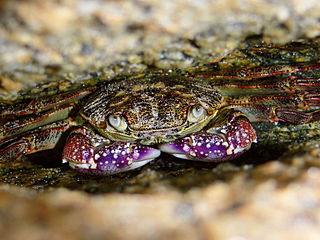
Leptograpsus variegatus, known as the purple rock crab, is a marine large-eyed crab of the family Grapsidae, found in southern subtropical Indo-Pacific Oceans. It grows to around 50 millimetres (2.0 in) shell width. It is the only species in the genus Leptograpsus.

Xantho hydrophilus, the furrowed crab or Montagu's crab, is a species of crab from the family Xanthidae. It is yellowish-brown and grows to a carapace width of 70 mm (2.8 in). It is a nocturnal omnivore that lives in shallow marine waters from western Scotland to the Cape Verde Islands.
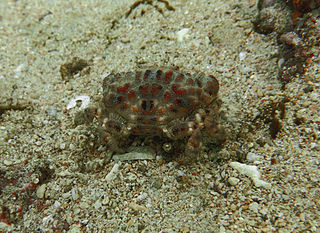
Paractaea is a genus of crabs in the family Xanthidae, containing the following species:

Cymo is a genus of crabs in the family Xanthidae, containing the following species:
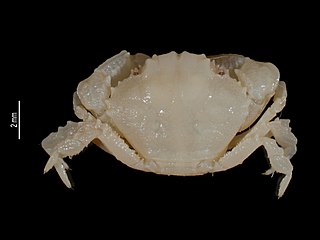
Paramedaeus is a genus of crabs in the family Xanthidae, containing the following species:
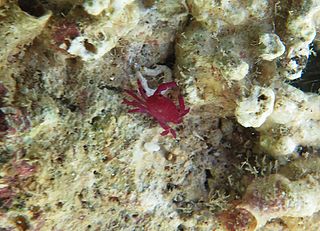
Liomera is a genus of crabs in the family Xanthidae. It contains the following extant species:

Neoliomera is a genus of crabs in the family Xanthidae, containing the following species:
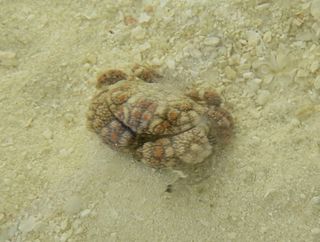
Pseudoliomera is a genus of crabs in the family Xanthidae, containing the following species:

Glyptoxanthus is a genus of crabs in the family Xanthidae, containing eight species. It was originally erected by Alphonse Milne-Edwards in 1879 for six species previously placed in the genus Actaea and elsewhere. Although previously included in subfamily Euxanthinae, the genus has a quite distinct morphology from other genera in that group, and was placed in 2011 in the new, monotypic subfamily, Glyptoxanthinae by Jose Christopher Mendoza and Danièle Guinot.

Guinotellus melvillensis is a species of crabs in the family Xanthidae, the only species in the genus Guinotellus. It is a benthic crab with an ovate carapace within the subfamily Euxanthinae.

Xanthias is a genus of crabs in the family Xanthidae, containing two exclusively fossil species and the following extant species:

Atergatis is a genus of crabs in the family Xanthidae, containing the following species:
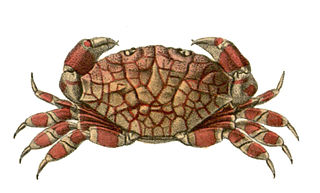
Lophozozymus is a genus of crabs in the family Xanthidae, containing the following species:

Dyspanopeus sayi is a species of mud crab that is native to the Atlantic coast of North America. It has also become established outside its native range, living in Swansea Docks since 1960, the Mediterranean Sea since the 1970s, the North Sea since 2007 and the Black Sea since 2010. It can reach a carapace width of 20 mm (0.8 in), and has black tips to its unequal claws. It feeds on bivalves and barnacles, and is in turn eaten by predators including the Atlantic blue crab, Callinectes sapidus. Eggs are produced from spring to autumn, the offspring reach sexual maturity the following summer, and individuals can live for up to two years. The closest relative of D. sayi is D. texanus, which lives in the Gulf of Mexico; the two species differ in subtle features of the genitalia and the last pair of walking legs.
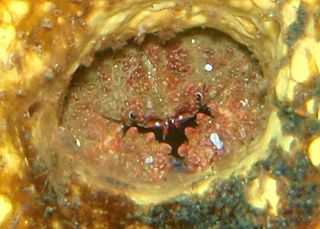
Pilumnoides is a genus of crabs in the family Pilumnoididae. The genus was erected by Hippolyte Lucas in 1844. It contains the following species:

Actea savignii is a species of Indo-Pacific crab from the family Xanthidae which is one of the spiny-legged rock crabs. It has colonised the Levantine Sea by Lessepsian migration through the Suez Canal from the Red Sea since the mid 2000s.

Gothus teemo is a species of crab and the type species of the genus Gothus. It was discovered in 2024 by Zi-Ming Yuan, Wei Jiang, and Zhong-Li Sha, based on specimens in the South China Sea. It is named after the board game Go as well as the League of Legends playable character Teemo.




















